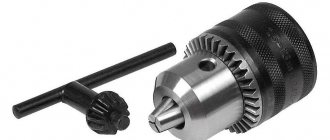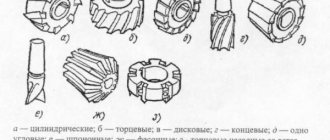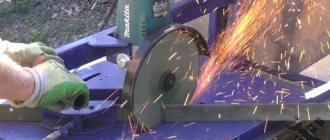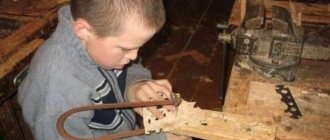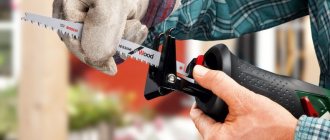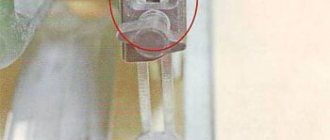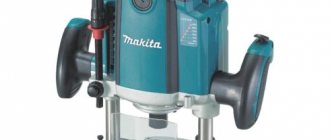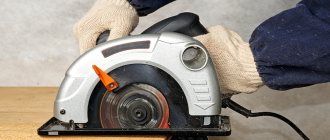Changed and forgot | 03/11/2016
A wood spade drill has higher productivity than a standard twist drill. The feather bit works well for drilling large-diameter holes in both regular and laminated wood, as well as in plastic and plasterboard. In terms of quality and accuracy of work, they are imperfect, and therefore are usually used for rough operations.
What is a feather drill?
The drill has the form of a rod, at one end of which there is a working part, and at the other - a hexagonal tip. The cutting blade has the appearance of a “feather”, having a central tip and two incisors extending from it.
All feather drills can be divided into single-sided and double-sided, designed to work in one and two directions, respectively. The cutting angle of the cutter of a single-sided pen is 75-90°, and that of a double-sided pen is 120-135° .
A wood drill bit has several advantages. Undoubtedly, the main one is cost. In terms of price-effectiveness ratio, it has no equal. Compared to a Fostner drill, the feather bit is much cheaper and has a wider range of working diameters.
The length of the drill is 15 cm. Using an additional extension, the depth of the drilled hole can be increased by 3 cm. The drill is ideal for creating small holes with a diameter of up to 60 mm.
In addition, the simple shape of the pen allows you to sharpen it yourself with a file or on a machine. As practice shows, they can even drill tin and thin sheet metal. Thanks to the hexagonal tip, the likelihood of the drill turning in the chuck is completely eliminated.
Let's talk about "feathers" on wood
Very often, home craftsmen use feather drills to drill wood, both regular and laminated wood. What are their advantages and disadvantages - read in this article.
A feather drill (hereinafter referred to as a feather drill) is used when drilling large-diameter holes in wood, the most important thing here is that the quality of the cut should not worry the master, the edges of the hole turn out to be a little uneven and “hairy”. However, if you need to lay a water pipe from the underground into the house through a floorboard, then you won’t find a better drill, I mean price-quality.
This type of consumable is several times cheaper than a screw drill and is better suited for one-time work.
Of course, you can also drill large diameter holes using a Forstner drill, but note that a Fosner will not be able to drill deep. The length of the “feather” is approximately 18 cm, while the Forstner drill is very short, 10 centimeters, and yet it is more suitable for drilling finishing holes of large diameter (up to 60 mm).
Forstner drills cleaner, perka - the edges are “hairy”.
The advantages of this consumable:
- Low price (compared to other wood drills)
- Many diameters (choose for your work)
- Versatility (people even drill sheet metal/tin with them)
- It is possible to extend the drill by another 300 mm
The wood chisel has a center, which is used for initial penetration into the tree, and 2 cutting teeth along the edges, which outline a circle and cut along the circumference. It is very easy to drill with it, especially if the diameter is required up to 30 mm. Above 30 mm, drilling is already worse. To work, you will need a regular drill, even with a low power of 500 watts. You can also drill with shurik and perfach.
In the video below, the master is working with different types of perks, all of them made from Soviet ones with a thick shank. But these are no longer available for sale))
The size range of feathers starts from 10 mm and ends with a rather large diameter of 60 mm. If you need to drill a hole larger than 60 mm, then hole saws, the so-called crowns, will come to your aid. Of course, their cost will be higher, all because they usually come in sets.
Another note: Carbide drill - we work on brick and concrete
How to increase the drilling depth with a pen?
The answer is simple - on sale you can find special extension cords that cost around 100 rubles, but are suitable for most sizes. They look like this:
We inserted the percussion, clamped it with a 3 mm hex key and we were ready to work. The length of this extension is 300 mm. Of course, for drilling deep, large-diameter holes, it is better to use screw drills, since a drill with an extension is a flimsy design, needless to say.
Well, we note that special jigsaw files designed for curved sawing will also help us in cutting out large diameters in wood. You simply first drill the board with a regular drill for wood or metal (diameter 5-6 centimeters), then insert a jigsaw file and start sawing in a circle. Of course, it will be difficult to cut out a perfectly round hole with a diameter of less than 80 mm with a jigsaw, but what to do if you have no choice.
In general, the “feather” is an excellent option in the price-quality category when you need to make a “hole” with a diameter of 14-50 mm, shallow (up to 150 mm). In such cases, you shouldn’t look for something special, buy a pen, it will work perfectly, and besides, you won’t spend a lot of money, since the price of such drills is low (when compared with the same screw drills or Forstner ones).
Feather drills are sold both individually and in sets that include the most popular diameters. A home craftsman must have such a tool in his arsenal, preferably at least 4-5 diameters.
Advantages and disadvantages of a feather drill
The main disadvantage is the inability to drill holes with diameters larger than 60 mm . During the drilling process, the material is destroyed only by the sharpened cutters of the end part of the nozzle. At this time, the rounded sides of the feather rub against the edges of the hole, leaving small hairs of wood on them and giving the surface a slight roughness. This spoils the view a little.
The negative aspects include the fact that a feather drill for wood loses its cutting properties relatively quickly.
| Name | Advantages | Flaws |
| Spiral | · Smooth surface of the edges of the hole; · Great depth. | · The largest drill has a relatively small diameter; Through holes only |
| Forstner drill | · Smooth walls; · Possibility of drilling holes of large diameters; · Long service life. | · High price; · Short shank, which does not allow deep penetration into the wood |
| Feather | · Low price; · Large number of diameters from 5 to 60 mm; · Possibility of using an extension that allows you to increase the depth of drill passage by 30 mm; · Can be sharpened by yourself. | · Rough edges of the hole. |
Feather drill sizes
With this tool you can easily make a hole with a diameter from 25 mm to 6 cm. Judging by consumer reviews, the most popular are 50 and 60 mm wood drill bits. If it is necessary to cut a hole whose diameter exceeds 6 cm, the master will have to use other drills, since feather drills are not suitable for covering large areas.
Read also: Metal with the highest thermal conductivity
During the manufacturing process of drills for tools, finishing is provided. Its task is to give the product increased strength. Several processing options are used in production. Each of them gives the product certain performance characteristics. During the process, a coating is applied to the surface of the drill, the color of which can be used to judge the performance properties of the tool:
- Black attachments have increased durability. In production, superheated steam is used for their finishing.
- The drills are golden yellow in color and have no metallic stress.
- Bright golden nozzles are treated with titanium nitride, thereby increasing the service life of the products.
- Tools that have not undergone finishing are gray in color.
It is recommended to consider this aspect when purchasing a set of feather drill bits for wood.
Feather drills for wood. Dimensions
You can purchase drills either individually or in a set. Often craftsmen buy a whole set at once. It usually includes pen nozzles of the following diameters: 10, 12, 16, 18, 20, 25 - these are the most common sizes that cope with their tasks quite easily .
You can buy a wood drill bit individually or to order in absolutely any size up to 60 mm. It is not advisable to produce and use feather bits with a diameter of more than 60 mm - due to the large area covered, the cutters destroy wood with great difficulty.
Features of operation
- Before starting work, the drilling area is carefully marked and clear boundaries are drawn. If there are many of them, then the depth of each is indicated.
- It is recommended to use a drill with variable speed control. This will make the job easier.
- The drill rotation range does not exceed 600 rpm. The golden rule is that the larger the hole diameter, the lower the head rotation speed and vice versa.
- An adapter is used to increase the drilling depth. One end of it is inserted into the cartridge, and the other into the tail section.
- The angle between the drill and the wooden surface is always 900. Otherwise, the tip may break and the workpiece may deteriorate.
- The main thing in work is the smooth increase in speed.
- Wood shavings are removed periodically.
Every craftsman should have feather drills for wood. They are easy to use. They are durable, productive, and easy to sharpen. The low price allows you to have several models of different sizes in stock.
Terms of use
It is necessary to operate the drill taking into account the following nuances:
- before starting drilling, it is necessary to mark the place where the hole will be drilled and make a small indentation with a core;
- For work, it is best to use a drill with a speed controller. The operating speed of the drill directly depends on the diameter of the pen used - the larger the drill, the lower the frequency the shaft should rotate. Working at high speeds will lead to rapid wear of the cutters or breakage of the drill itself;
- if the pen nozzle is intended to be used for drilling deep holes, then you must immediately purchase an extension cord. It has a special lock that is clamped with a 3 mm hex key, thereby allowing the drill and extension to work as a single unit;
- In order to correctly outline the hole, at the very initial stage it is necessary to rotate the shaft as slowly as possible. It is important to set the drill perpendicular to the surface on which the hole is planned, and press the tip with little force;
- the pen is designed so that the sawdust of the wood being drilled does not come out and remains in the hole. Therefore, it is necessary to periodically stop work and blow out chips from the groove.
What to look for when purchasing?
A very large number of companies and firms are engaged in the production of feather drills. In order not to be disappointed in the instrument, when purchasing you need to pay attention to the following points:
- shape - the feather must have symmetry;
- the cutters must be perfectly smooth, which may indicate factory manufacturing conditions;
- the presence of chips and irregularities only indicates that the instrument was made in artisanal conditions, which does not add any advantages to the quality;
- color.
The last external sign is worth paying special attention to. The color of the drill can indicate how well the metal was processed .
| Color | Features of technological processing |
| Steel with a gray tint | The part has not been processed |
| Dark | Heated steam treatment was carried out, due to which the strength of the metal increased |
| Gold | A special processing technology with material removal using internal pressure was used |
| Bright golden | Indicates the presence of a titanium nitride layer on the surface of the drill, which significantly increases the service life and increases the strength characteristics |
Basic information
What exactly makes the feather-shaped drill stand out from other samples designed for drilling wood surfaces? Let's figure it out.
Comparison with other models
Photo of a twist drill for working with wood
As we have already noted, consumables for drills that are designed to work with wood can have different shapes.
Let's take a quick look at all the possible options:
| Name | pros | Minuses |
| Spiral | · Smooth edges of the hole; |
· Large passage depth.
Through holes only
· Creation of blind holes;
· Possibility of creating passages of large diameters;
· Durability.
· Short shank, which does not allow deep penetration into the wood.
· Wide range of possible diameters from 5 to 76 mm;
· Possibility of extending the drill by 30 cm using a special attachment;
· Easy to use with your own hands;
· Possibility of sharpening.
Tip: to create holes whose diameter exceeds 60 mm, it is recommended to use special “crowns” with a sawtooth edge. With a feather drill of this size, the edges of the cut may be too torn.
Sample of a crown for working with wood
Buying expensive tools for one-time use is not cost-effective. But the feather model is quite universal and the most affordable, which makes it convenient for every owner to have in their toolkit.
Steel drill bit for wood 40 mm
Advice: due to their low cost, it is advantageous to buy feather drills as a set. Then you will always be ready to drill a hole of almost any size needed.
Various sizes of wood drill bits in one set
Design Features
Compared to the more expensive models discussed above, the structure of a feather drill looks elementary:
- The working part is a flat blade with a sharp protrusion in the center, from the tip of which a sharp edge begins, leading to one of the edges of a kind of feather and sloping to the right. The thickness and width of the cutting element of the drill have the following ratio:
| · Relatively small limit of possible diameter; | |
| Forstner drill | · Smooth edges; |
| · Quite a high price; | |
| Feather | · Low cost; |
| · Not very clean hole edges. | |
| Width (diameter), mm | Thickness, mm |
| 5-10 | 1,-2 |
| 10-20 | 2-4 |
| 20 or more | 6-8 |
Cutting edge of a feather drill
- The tail part is shaped like a hexagon, which is suitable for drills, screwdrivers, as well as all kinds of magnetic adapters and extension cords.
There are no such complex fragments in the form of a spiral or a drill, which simplifies even the moral approach to using a feather drill.
Features of choice
Point drill 23 mm, treated with hot steam
When buying a drill, of course, you want to get a high-quality sample, and for this you should pay attention to a number of external signs:
- Correct form. Linear dimensions must be symmetrical.
- Sharpness of incisors. The sharpening must be of a factory nature.
- No defects. The presence of visible flaws indicates the “handicraft” method of manufacturing the drill, which does not speak in favor of its quality.
- Color. The shade of steel can say a lot about the processing carried out on it:
Read also: Lack of penetration is a defect in the form
| Color | Features of the production process |
| Steel gray | There was no processing at all |
| Black | Treatment with heated steam was carried out, due to which the strength of the metal increases |
| Golden | A special treatment was carried out using internal pressure material removal |
| Bright gold | Indicates the presence of a titanium nitride layer on the tool, which significantly enhances its strength characteristics and service life |
Exploitation
Instructions for using feather drills are as follows:
- We apply markings on the wooden surface that we plan to drill.
- To perform the work, it is better to take a drill with a power regulator. With a feather tool, it is best to operate at 200-500 rpm, and the larger the diameter of the drill hole, the lower the operating speed of the device is set. That is, for example, a 60 mm wood drill bit will work better at lower speeds.
- If you need to drill to a greater depth, then insert a special adapter into the chuck. If the length of a simple drill is quite enough to complete the task you have planned, then we immediately fix its shank in the drill head.
Installed “feather” in the drill chuck
- We bring the tool strictly perpendicular to the place where we want to drill a circle, and press the sharp tip to its center.
- Let's start drilling. As you deepen, you can increase the number of revolutions made.
Start of drilling according to the applied markings
- As the chips accumulate, we stop, remove the drill and clear the opening of debris.
Released chips must be removed manually
- We reach the desired mark, after which we finish the work.
Finished hole made using a pen tool
Sharpening
With other models the situation is more complicated, but sharpening the “feathers” at home is quite easy. To do this, you will need a sharpening machine with a diamond wheel, or even just a quality rule.
Next we do this:
- We take a new feather drill as a sample.
- Based on his example, we derive the incisors of the dull one.
- We pay special attention to not knocking off the center.
If the deformation of the blade is already too great, then you should not try to restore it, it is better to buy a new one, especially since feather drills are inexpensive.


